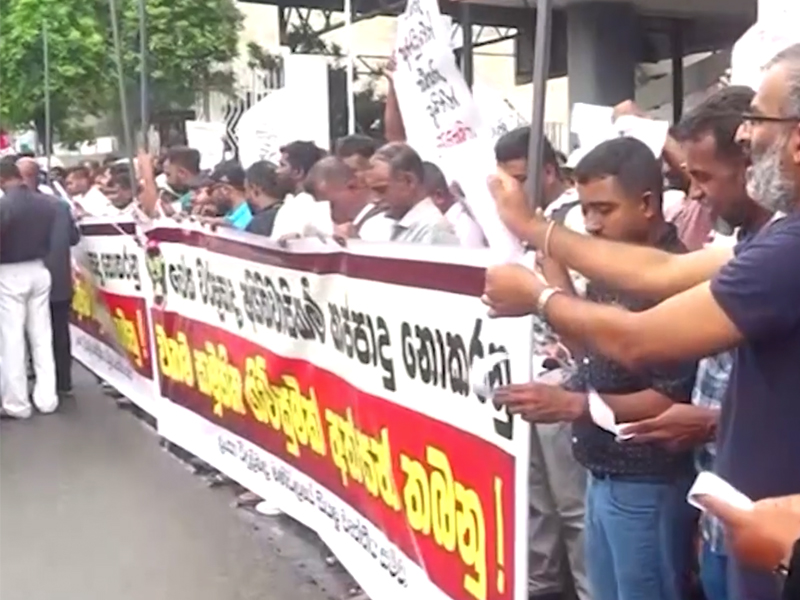-By Sunil Gamini Jayalathge

(Lanka-e-News - 27.Sep.2025, 11.30 PM) When the Ceylon Electricity Board (CEB) trade unions embarked on an “illness strike” on 4 September, few anticipated the storm that would follow. By 24 September, they had prepared to paralyse the country with a mass walkout—only to retreat at the last minute. The unions claimed they were defending the public from the “privatisation” of the CEB. Yet, scratch beneath the slogans, and a far murkier picture emerges—one in which defeated politicians, discredited political parties, and a clique of corrupt engineers appear to be orchestrating the disruption.
Union leaders insist they submitted 24 demands to the government. Yet not one of these has been made public. In fact, the grievances paraded before television cameras have little to do with privatisation. Instead, the demands echo familiar territory: salary hikes, perks, and allowances that successive governments have long refused to grant. The rhetoric of “saving the CEB” appears to be little more than a convenient soundbite.
Privatisation, of course, is not a fiction. The most radical attempt to carve up the CEB came under Ranil Wickremesinghe’s presidency, with his energy minister, Kanchana Wijesekera, tabling legislation in 2024 to divide the CEB into six private companies: generation, transmission, distribution, trading, supply, and processing. Coal, diesel, and even hydro plants were to be auctioned off to private investors. That bill scraped through Parliament on 6 June 2024 with a majority of 44 votes. Crucially, it earmarked 12,000 jobs for termination by August that year.
Those plans collapsed with the change of government. The Malima administration passed new legislation in August 2025, restructuring the CEB into four state-owned entities—generation, transmission, distribution, and system management—all owned entirely by the Treasury. Every one of the 23,000 employees was guaranteed placement in the new structure, with voluntary retirement available but no forced dismissals. A new pension and compensation package, capped at Rs. 5 million, was introduced on equal terms for all.
In short: no privatisation, no mass sackings. Which begs the question—why strike at all?
The answer lies less in public service than in vested interest. For decades, the Engineers’ Union within the CEB wielded enormous influence over hiring, tenders, and procurement. Many of its senior figures were accused of colluding with politicians to overstaff the Board with political appointees, manipulate tenders, and skim off contracts. When ministers such as Ajith P. Perera, Pavithra Wanniarachchi, and John Seneviratne packed the CEB with their supporters, it was these engineers who facilitated the process—in return for plum salaries, promotions, and perks.
Some memories are long. In January 2015, on the eve of Mahinda Rajapaksa’s electoral defeat, the Engineers’ Union pushed through a 120% pay hike for themselves by circular. The same clique now presents itself as the saviours of the common worker.
Among the figures leading the current agitation is one “Gamage”, a CEB electrical superintendent with a chequered past. He once contested a presidential election under the “Bhumi Putra” banner and was reportedly caught accepting bribes from a supermarket owner during his tenure in Kegalle. He is today banned from even entering the CEB canteen. Yet, improbably, he is presented as a workers’ champion.
The government’s restructuring threatens to slam shut the doors on such corruption. No longer will politically connected engineers be able to channel lucrative contracts to their family-owned suppliers of vehicles, IT systems, and machinery. No longer will foreign junkets, funded through bloated tenders, be the norm. And no longer will political mafias treat the CEB as a recruitment agency.
This explains the fury of both the unions and their political backers. For the defeated parties of the past—the SLFP, the UNP, and the Rajapaksas’ SLPP—the strike is an opportunity not to “save” the CEB but to destabilise the current government. Their engineers’ mafia knows only too well that reform means the end of their golden era.
At the same time, the financial picture is shifting. Sampath Bank has just led a landmark syndicated loan of Rs. 33.5 billion to the CEB, joined by Nations Trust Bank and Pan Asia Bank. This injection will help restructure the CEB’s debt and stabilise its operations, ensuring electricity supply continues uninterrupted. It also underscores the confidence of the domestic banking sector in the government’s reforms.
“This facility underlines the collective strength of Sri Lanka’s financial system in supporting national institutions,” said Sampath Bank’s Managing Director, Sanjaya Gunawardana, at the signing.
The government argues it is not bowing to union blackmail. For the first time in decades, a reform is underway that promises no mass sackings, no privatisation, and a pension system more generous than the state norm. Yet the unions persist. Why? Because what is at stake is not the public interest, but the ability of a small, entrenched elite to continue treating the CEB as their personal fiefdom.
The strikes are not about workers’ rights. They are about power—both electrical and political. The unions, backed by defeated politicians and corrupt engineers, are less interested in protecting the consumer than in resurrecting a discredited order.
If the government capitulates, it will not be reform that fails—it will be the nation. That is why, as the author bluntly concludes, these “ignoble trade union actions” must be decisively defeated.
-By Sunil Gamini Jayalathge
---------------------------
by (2025-09-27 19:14:45)
Leave a Reply